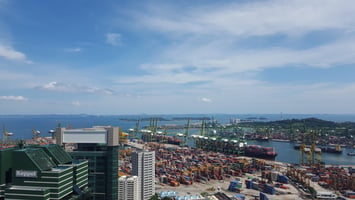In this article, we will look into the four types of materials that represent the most commonly...
Manufacturing in Singapore: Common Objections
Moving your manufacturing elsewhere is a big decision, especially if this is your first move outside your country. Singapore may seem foreign and far away, and you may have some concerns about operating in such a different environment. We rounded up the most common objections to manufacturing in Singapore that we've encountered.
Read on to see if you share the same concerns.
#1: Singapore is too small
At just 722.5 km2, it’s undeniable that Singapore is small.
The key is in dividing your manufacturing activities between Singapore and the region, depending on how labor- and land-intensive they are.
MNCs here, as well as Singapore’s small and medium businesses, follow this model.
They are shifting their lower-value manufacturing activities into neighboring countries -- mostly Malaysia, Vietnam, Indonesia, and Thailand. This helps to increase capacity, especially for land-intensive manufacturing activities that don’t need highly skilled employees.
By setting up your Asia headquarters here, you can have access to the resources of the region while benefiting from Singapore’s business-friendly policies and relatively low corporate tax.
Singapore’s transport hub status -- both for air travel and shipment of goods -- makes it easy for you to access the rest of Southeast Asia.
#2: Singapore is too expensive
With Singapore being ranked as the world’s most expensive cities for expatriates to live in, it’s no wonder that many associate Singapore with the word expensive.
But if the net cost of operating out of Singapore is indeed expensive, why do 7,000 MNCs operate out of Singapore?
The truth is, Singapore offers a world of benefits that outweigh that cost.
While it may be difficult to economically recruit locals for some jobs, you can still benefit from low costs of labor in the region by recruiting some workers from Malaysia and China.
Affordable rental options for industrial infrastructure are also available through the statutory board JTC.
Besides, Singapore is also big on productivity.
Kaizen has a long history in Singapore -- it’s been at the heart of Singapore’s manufacturing scene since the 1980s when a large Productivity Development Project was carried out with the help of the Japanese. The concept of Kaizen is now deeply entrenched in Singapore’s manufacturing culture.
Today, the government still actively incentivizes companies to invest in automation and other solutions to further improve their productivity and reduce their dependence on labor.
#3: I don't want to do business in Singapore Dollar
From our experience, this hasn’t been an issue at all. Most companies accept payment in USD, and you can open bank accounts in USD in most banks in Singapore.
#4: There is too much time difference
A 12-hour time difference with the US East Coast and 15-hour difference with the West Coast. That must be quite troublesome, right?
But in our experience, it’s quite the opposite. This time difference has actually turned into an asset. Let me explain why:
When you send a request to a supplier in Singapore at the end of the US workday -- let’s say 6 PM -- it’s 6 AM in Singapore. By the time you come back to work the next day at 8 AM, the supplier has had all day to reply. Most likely, you’ll come back to the office with that problem already solved while you’re asleep.
Isn’t that great?
#5: I don't speak Mandarin
Well, this is a common misunderstanding.
Indeed, the ethnic Chinese make up the majority of Singapore’s population. But that doesn’t mean that the Chinese language is the business language used here. Most Chinese Singaporeans learn it in school as a second language and maybe speak it at home.
English is the lingua franca here and has been the medium of instruction in Singapore’s schools since 1987. It is also the main language used in formal settings, such as in the government and in the courts.
In fact, English has in recent years become the most commonly spoken language at home among Singapore residents, so a language mismatch problem will be the least of your worries.
***
These are our top five most common objections to manufacturing in Singapore.
Have we addressed your concerns?
If you have any other questions about doing business in Singapore, we’re happy to help. Feel free to contact us here for a chat!
-1.jpg?width=146&height=50&name=Kusu%20(1)-1.jpg)



